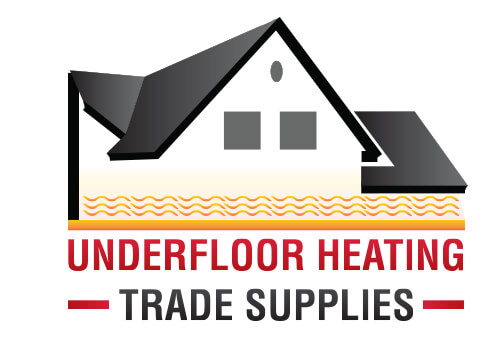
Improve your home office space with the warmth and efficiency of the right office heating systems. Discover how the right heating solutions can elevate your workspace.
As more professionals opt for remote work, the need for a comfortable and functional home office is more important than ever, especially during the colder months. In this article, we will explore suitable heating solutions that blend seamlessly into your office design. We’ll guide you through the benefits, installation insights, and cost-effectiveness of electric and water-based underfloor heating options tailored for any home office.
Key Points:
- Grasp the benefits of incorporating underfloor heating in your home office.
- Investigate aesthetically pleasing heating solutions that enhance your workspace.
- Acquire knowledge about the installation and ongoing costs of underfloor heating systems.
- Obtain insights into selecting the best underfloor heating system—electric versus water-based—for your area.
- Learn about legal temperature standards and strategies for maintaining optimal warmth.
Understanding Office Heating Systems and Temperature Regulations
Under the Workplace (Health, Safety and Welfare) Regulations 1992, it’s mandated that employers maintain a ‘reasonable’ office temperature. This requirement aims to ensure that office environments are neither excessively hot during summer nor unbearably cold in winter. Typically, the minimum temperature for office spaces is set at 16℃. Whilst this is different from your home office space, it is nevertheless important to consider these temperatures regardless of the size of the office space when seated for long periods of time.
In more physically demanding work environments, like those involving heavy lifting, the temperature should not drop below 13℃. Although these standards are guidelines rather than enforceable laws, they emphasise an employer’s responsibility to provide a comfortable working temperature.
Assessing the Right Temperature for Your Office
To determine whether your office heating system is adequate, you can refer to the HSE’s Thermal Comfort Checklist. This tool helps assess factors such as air temperature, movement, and humidity. If this assessment indicates potential discomfort, it may be necessary to conduct a detailed risk assessment to ensure that the office heating systems are effectively maintaining comfortable conditions.
Efficient Heating Strategies for Home Office Spaces

When setting up a home office, ensuring a warm and inviting atmosphere is crucial, especially during colder months. Traditional heating methods, such as wall-mounted radiators, electric convector heaters, and oil-filled radiators, often fall short in efficiency and sustainability. These solutions can consume valuable space, detract from your decor, and in the case of wood-burning stoves, release significant amounts of CO2, posing environmental concerns.
Using Natural Sunlight

One simple yet effective strategy is to use natural sunlight as a heat source during the day, allowing it to warm the office space. As dusk falls, closing blinds and curtains can help retain this heat, acting as additional insulation. For larger office spaces, keeping doors closed ensures that heat does not escape unnecessarily, maintaining a warm environment for longer periods.
Eliminating Cold Draughts
The ‘stack effect’ can lead to significant heat loss. This phenomenon occurs when warm air rises and escapes, pulling in cold air from outside. To combat this, ensure that all potential entry points for cold air, such as windows and doors, are well-sealed. Minimising the openings reduces the influx of cold air, which helps maintain a steady office temperature and reduces heating costs.
Strategic Furniture Placement
To facilitate better air circulation, avoid placing furniture directly against radiators or heating vents. This common mistake can obstruct warm air flow, making the heating system work harder and less efficiently. By positioning furniture away from direct heat sources, you allow warm air to circulate freely, which efficiently heats the space.
Using Portable Heaters Wisely
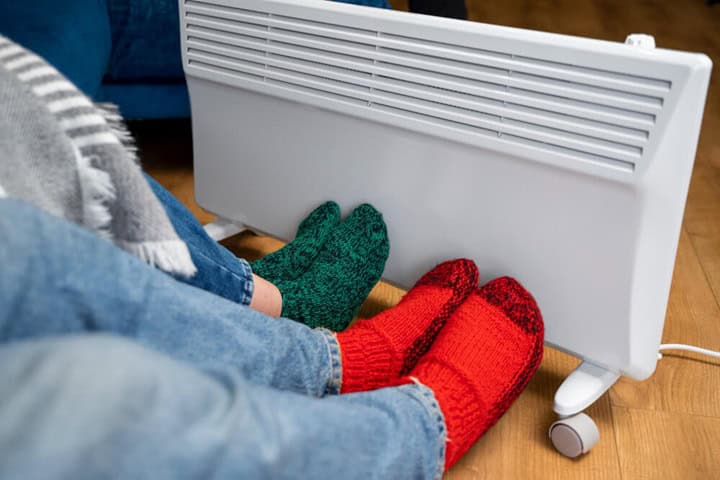
Portable heaters can be an excellent supplement to your main heating system, especially in areas that are not continuously used throughout the day. They provide targeted warmth and can be particularly useful in large, open-plan offices where traditional heating might not reach effectively. Additionally, options like under-desk foot heaters or free-standing units in meeting rooms offer flexibility and can enhance comfort without the high cost of heating less occupied spaces.
Incorporating Smart Thermostats
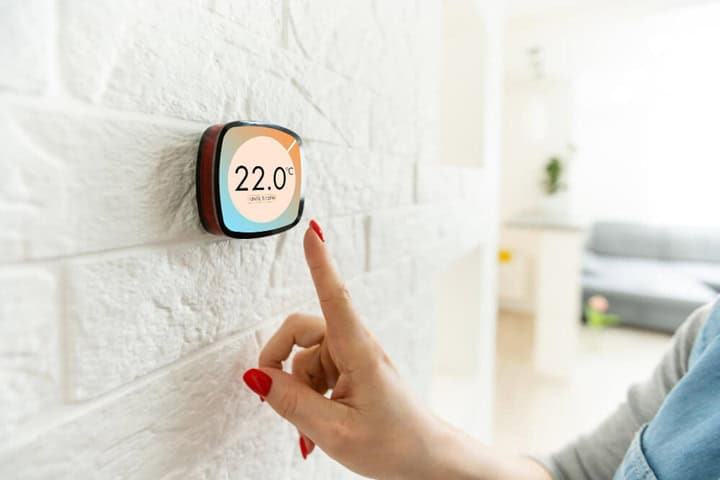
Installing a smart thermostat can revolutionise how you control your office heating. Unlike traditional thermostats, which may require manual adjustment, smart thermostats adjust heating based on real-time temperature changes and can be controlled remotely. This technology not only improves comfort but can also lead to significant cost savings by optimising energy usage.
Discreet Underfloor Heating Options For A Home Office
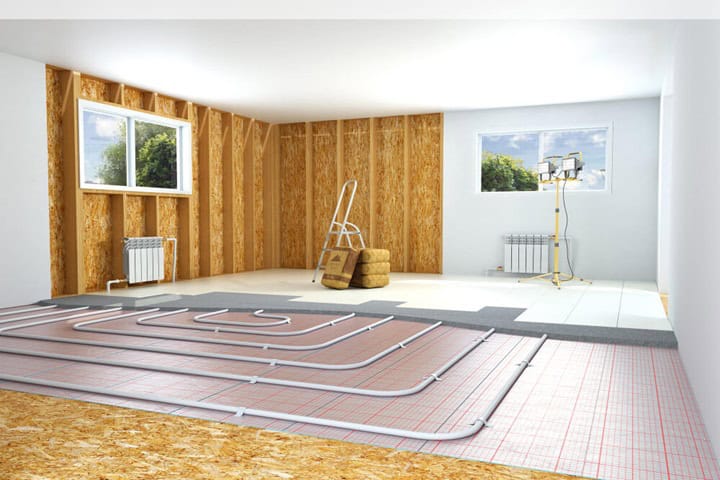
Underfloor heating (UFH) systems present a superior alternative, offering both comfort and aesthetic benefits. By employing radiant floor heating technology, UFH systems directly warm objects and people in the room, providing a more consistent and comfortable heat compared to conventional heating methods. This system is not only more energy-efficient but also discreet, with no visible components to disrupt your office’s interior design.
For those retrofitting an existing room, electric underfloor heating systems are ideal. These systems feature slim heating cables or mats that fit seamlessly under your flooring without altering floor heights. They are particularly suited for regular-shaped rooms and can be quickly installed.
Considerations for New-Build Offices
In new constructions, such as extensions or annexes, water underfloor heating systems are worth considering too. These systems circulate heated water through pipes under the floor, often requiring a deeper installation but offering greater efficiency for larger spaces. Learn more in our retrofitting underfloor heating guide.
Effective Heating Strategies for Large Offices
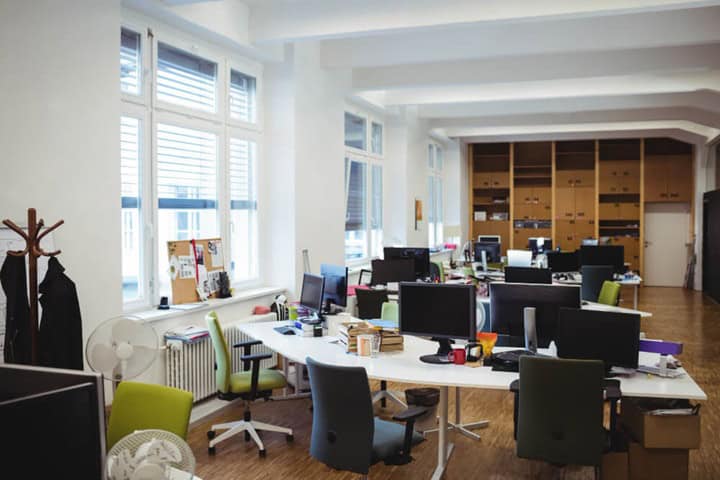
Large office spaces often face unique challenges when it comes to maintaining a comfortable temperature, and require more measurements and maintenance when compared to home office heating solutions.
Heat Pumps
Traditional warm air systems, such as heat pumps, are common in vast areas like warehouses but can lead to uneven heating, with heat accumulating at the ceiling and leaving the lower areas cold. To address this, destratification fans can be employed to circulate warm air more evenly, reducing energy consumption and improving comfort across all levels of the space.
Since there are two main forms of heat pumps, you can learn more about them and how they can be integrated with other heating systems such as underfloor heating with these articles:
Air Rotation
In large office environments, optimising the circulation of heated air can significantly improve overall energy efficiency. Utilising high-powered fans to rotate the air helps distribute heat more evenly throughout the space. This can be especially useful in buildings with existing heating units, prioritising their effectiveness without the need for costly upgrades.
Harnessing Natural Heat
While it’s not a complete solution (especially with the unpredictability of UK weather), making the most of sunlight can provide a natural boost to your office heating. During sunny winter days, opening blinds and curtains to let sunlight in can naturally warm your space, although to a lesser extent than this would in the summer. As the sun sets or on cloudy days, closing them provides an additional layer of insulation, helping to retain the heat.
Draft Exclusion
Simple measures like sealing windows and doors can prevent heat from escaping your office. Investing in quality draft exclusion solutions, such as weather stripping or thermal curtains, can contribute to maintaining a consistent temperature and reducing heating costs.
Regular Maintenance
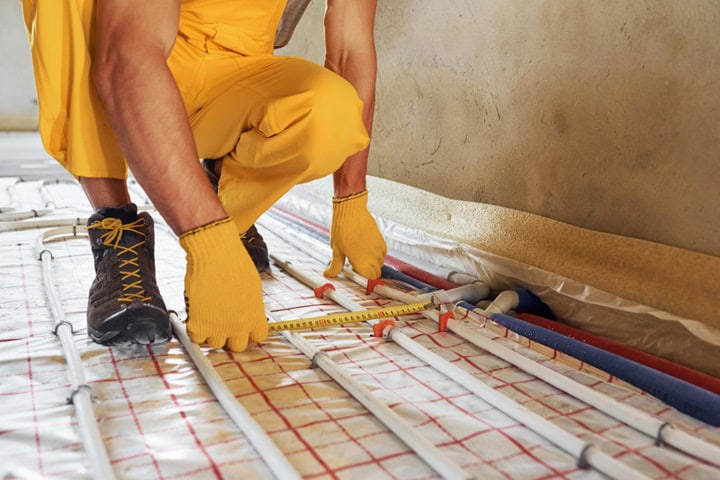
To ensure that an office heating system operates at peak efficiency, regular maintenance is crucial. This includes routine checks and repairs to prevent breakdowns and extend the lifespan of the heating equipment. Scheduled maintenance can also help identify potential issues before they become serious, ensuring that the office remains warm throughout the colder months.
Timers
Timers are an invaluable tool for managing heating in large spaces. They allow the heating system to begin warming the office before employees arrive and turn it off after they leave, ensuring the space is comfortable when needed without wasting energy overnight.
Optimise Your Office Heating With The Right Solutions
In conclusion, creating a comfortable and efficient home office is important for both productivity and well-being. From the strategic use of underfloor heating systems to using traditional central heating systems and incorporating smart thermostats, each method offers unique benefits. By understanding your specific needs and implementing these effective heating strategies, you can ensure your office remains warm and inviting throughout each working year.
FAQs
What are the safety concerns with office heating systems?
Key safety concerns include ensuring that all heating equipment is regularly inspected and maintained to prevent fire hazards. It’s also important to keep flammable materials away from heating equipment and ensure that carbon monoxide detectors are installed and functioning properly in offices with fuel-burning appliances.
How do I address uneven heating issues in a large office?
Uneven heating in large offices can be addressed by using zoning systems, which allow different areas to be heated to different temperatures. Also, ensuring that heating vents are not blocked by furniture or equipment can help improve air distribution.
Sources
Health & Safety Executive. (2013) Workplace health, safety and welfare. Workplace (Health, Safety and Welfare) Regulations 1992. Approved Code of Practice and guidance. [online] Available at: https://www.hse.gov.uk/pubns/books/l24.htm [accessed 07/01/2025]
Health & Safety Executive. (2007) Thermal comfort. [online] Available at: https://www.hse.gov.uk/temperature/thermal/ [accessed 07/01/2025]
